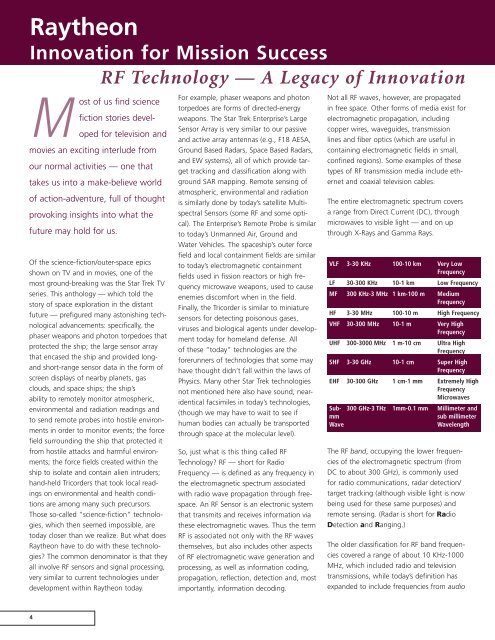Technology Today Volumn 3 Issue 1 - Raytheon
Technology Today Volumn 3 Issue 1 - Raytheon
Technology Today Volumn 3 Issue 1 - Raytheon
Create successful ePaper yourself
Turn your PDF publications into a flip-book with our unique Google optimized e-Paper software.
<strong>Raytheon</strong><br />
Innovation for Mission Success<br />
RF <strong>Technology</strong> — A Legacy of Innovation<br />
M<br />
ost of us find science<br />
fiction stories developed<br />
for television and<br />
movies an exciting interlude from<br />
our normal activities — one that<br />
takes us into a make-believe world<br />
of action-adventure, full of thought<br />
provoking insights into what the<br />
future may hold for us.<br />
Of the science-fiction/outer-space epics<br />
shown on TV and in movies, one of the<br />
most ground-breaking was the Star Trek TV<br />
series. This anthology — which told the<br />
story of space exploration in the distant<br />
future — prefigured many astonishing technological<br />
advancements: specifically, the<br />
phaser weapons and photon torpedoes that<br />
protected the ship; the large sensor array<br />
that encased the ship and provided longand<br />
short-range sensor data in the form of<br />
screen displays of nearby planets, gas<br />
clouds, and space ships; the ship’s<br />
ability to remotely monitor atmospheric,<br />
environmental and radiation readings and<br />
to send remote probes into hostile environments<br />
in order to monitor events; the force<br />
field surrounding the ship that protected it<br />
from hostile attacks and harmful environments;<br />
the force fields created within the<br />
ship to isolate and contain alien intruders;<br />
hand-held Tricorders that took local readings<br />
on environmental and health conditions<br />
are among many such precursors.<br />
Those so-called “science-fiction” technologies,<br />
which then seemed impossible, are<br />
today closer than we realize. But what does<br />
<strong>Raytheon</strong> have to do with these technologies?<br />
The common denominator is that they<br />
all involve RF sensors and signal processing,<br />
very similar to current technologies under<br />
development within <strong>Raytheon</strong> today.<br />
4<br />
For example, phaser weapons and photon<br />
torpedoes are forms of directed-energy<br />
weapons. The Star Trek Enterprise’s Large<br />
Sensor Array is very similar to our passive<br />
and active array antennas (e.g., F18 AESA,<br />
Ground Based Radars, Space Based Radars,<br />
and EW systems), all of which provide target<br />
tracking and classification along with<br />
ground SAR mapping. Remote sensing of<br />
atmospheric, environmental and radiation<br />
is similarly done by today’s satellite Multispectral<br />
Sensors (some RF and some optical).<br />
The Enterprise’s Remote Probe is similar<br />
to today’s Unmanned Air, Ground and<br />
Water Vehicles. The spaceship’s outer force<br />
field and local containment fields are similar<br />
to today’s electromagnetic containment<br />
fields used in fission reactors or high frequency<br />
microwave weapons, used to cause<br />
enemies discomfort when in the field.<br />
Finally, the Tricorder is similar to miniature<br />
sensors for detecting poisonous gases,<br />
viruses and biological agents under development<br />
today for homeland defense. All<br />
of these “today” technologies are the<br />
forerunners of technologies that some may<br />
have thought didn’t fall within the laws of<br />
Physics. Many other Star Trek technologies<br />
not mentioned here also have sound, nearidentical<br />
facsimiles in today’s technologies,<br />
(though we may have to wait to see if<br />
human bodies can actually be transported<br />
through space at the molecular level).<br />
So, just what is this thing called RF<br />
<strong>Technology</strong>? RF — short for Radio<br />
Frequency — is defined as any frequency in<br />
the electromagnetic spectrum associated<br />
with radio wave propagation through freespace.<br />
An RF Sensor is an electronic system<br />
that transmits and receives information via<br />
these electromagnetic waves. Thus the term<br />
RF is associated not only with the RF waves<br />
themselves, but also includes other aspects<br />
of RF electromagnetic wave generation and<br />
processing, as well as information coding,<br />
propagation, reflection, detection and, most<br />
importantly, information decoding.<br />
Not all RF waves, however, are propagated<br />
in free space. Other forms of media exist for<br />
electromagnetic propagation, including<br />
copper wires, waveguides, transmission<br />
lines and fiber optics (which are useful in<br />
containing electromagnetic fields in small,<br />
confined regions). Some examples of these<br />
types of RF transmission media include ethernet<br />
and coaxial television cables.<br />
The entire electromagnetic spectrum covers<br />
a range from Direct Current (DC), through<br />
microwaves to visible light — and on up<br />
through X-Rays and Gamma Rays.<br />
VLF 3-30 KHz 100-10 km Very Low<br />
Frequency<br />
LF 30-300 KHz 10-1 km Low Frequency<br />
MF 300 KHz-3 MHz 1 km-100 m Medium<br />
Frequency<br />
HF 3-30 MHz 100-10 m High Frequency<br />
VHF 30-300 MHz 10-1 m Very High<br />
Frequency<br />
UHF 300-3000 MHz 1 m-10 cm Ultra High<br />
Frequency<br />
SHF 3-30 GHz 10-1 cm Super High<br />
Frequency<br />
EHF 30-300 GHz 1 cm-1 mm Extremely High<br />
Frequency<br />
Microwaves<br />
Sub- 300 GHz-3 THz 1mm-0.1 mm Millimeter and<br />
mm sub millimeter<br />
Wave Wavelength<br />
The RF band, occupying the lower frequencies<br />
of the electromagnetic spectrum (from<br />
DC to about 300 GHz), is commonly used<br />
for radio communications, radar detection/<br />
target tracking (although visible light is now<br />
being used for these same purposes) and<br />
remote sensing. (Radar is short for Radio<br />
Detection and Ranging.)<br />
The older classification for RF band frequencies<br />
covered a range of about 10 KHz-1000<br />
MHz, which included radio and television<br />
transmissions, while today’s definition has<br />
expanded to include frequencies from audio

















